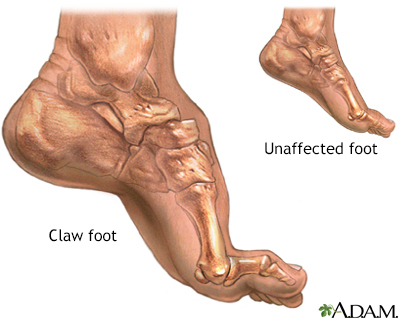Claw foot
Definition
Claw foot is a deformity of the foot. The joint of the toe that is closest to the ankle is bent upward, and the other joints are bent downward. The toe looks like a claw.
Alternative Names
Claw toes
Considerations
Claw toes may be present at birth (congenital). The condition can also develop later in life because of other disorders (acquired). Claw toes may be caused by a nerve problem in the legs or a spinal cord problem or signs of arthritis. The cause is unknown in many cases.
Most of the time, claw toes are not harmful in themselves. They may be the first sign of a more serious disease of the nervous system.
Claw toes may cause pain and lead to calluses on the top of the toe over the first joint, but may also be painless. The condition may create problems fitting into shoes.
Causes
Causes may include:
- Ankle fractures or surgery
- Cerebral palsy
- Charcot-Marie-Tooth disease
- Other brain and nervous system disorders
- Rheumatoid arthritis
When to Contact a Medical Professional
Contact your health care provider if you think you may be getting claw toes.
What to Expect at Your Office Visit
The provider will do an exam to check for muscle, nerve, and spine problems. The physical exam will most likely include extra attention to the feet and hands.
You will be asked questions about your condition, such as:
- When did you first notice this?
- Did you have a previous injury?
- Is it getting worse?
- Does it affect both feet?
- Do you have other symptoms at the same time?
- Do you have any abnormal feelings in your feet?
- Do any other family members have the same condition?
The abnormal shape of the toe can increase pressure and cause calluses or ulcers on your toes. You may need to wear special shoes to ease pressure. Claw toes can also be treated surgically.
Gallery

References
Grear BJ. Neurogenic disorders. In: Azar FM, Beaty JH, eds. Campbell's Operative Orthopaedics. 14th ed. Philadelphia, PA: Elsevier; 2021:chap 87.
Murphy GA. Lesser toe abnormalities. In: Azar FM, Beaty JH, eds. Campbell's Operative Orthopaedics. 14th ed. Philadelphia, PA: Elsevier; 2021:chap 84.
